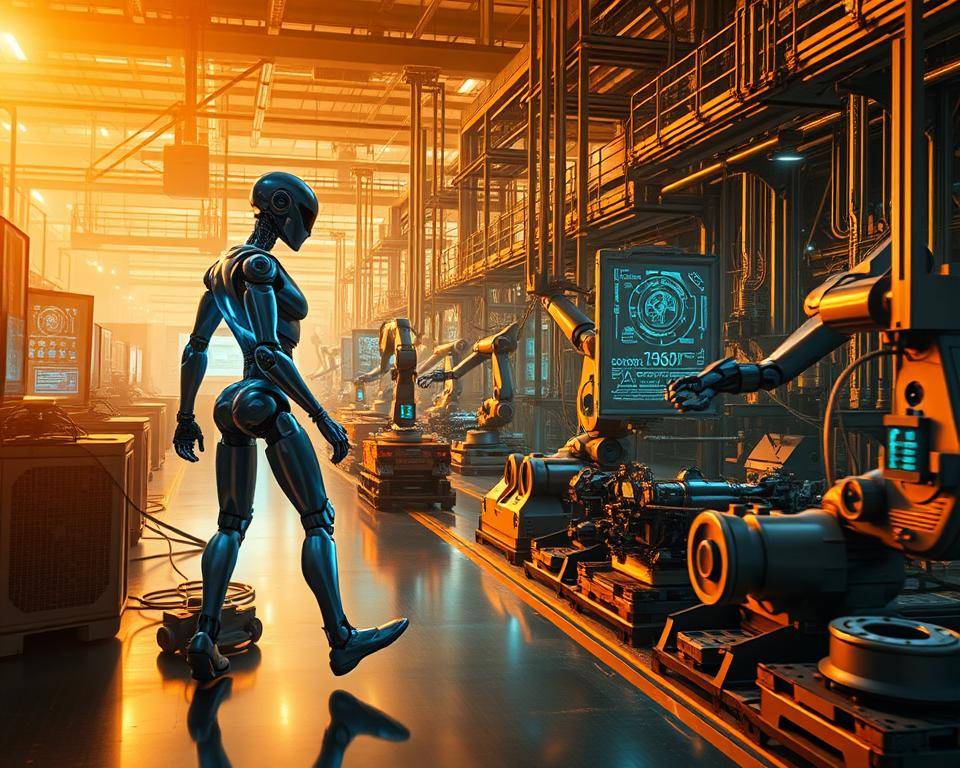Did you know that nearly 30% of tasks in the US workforce can be automated using existing technologies? This is a huge number that shows how much artificial intelligence automation can change work in many fields.
Companies are always looking for ways to work better and faster. Artificial intelligence is helping a lot. It makes things more efficient, accurate, and flexible.
Using AI in automation helps companies manage their work better. This leads to more done in less time and lower costs.
Key Takeaways
- AI is transforming traditional workflow systems.
- Automation enhances efficiency and accuracy.
- Businesses are adopting AI for workflow management.
- AI integration leads to improved productivity.
- Operational costs are reduced through automation.
The Rise of AI in Automation
The rise of AI in automation is changing how companies work. Now, employees use AI to automate simple tasks, improve workflows, and work better together. This trend will keep growing, with AI becoming more important in many industries.
Defining Intelligent Automation
Intelligent automation mixes AI and automation to make systems that can learn and decide. Machine learning automation helps these systems get better with time by analyzing data. This is different from old automation, which followed set rules.
Robotic process automation (RPA) also boosts intelligent automation. It lets systems handle complex tasks that need human thinking.
The Evolution from Traditional to AI-Powered Automation
The move from old to AI-powered automation has brought big changes. Old automation was based on rules and did simple tasks well. But it couldn’t learn or handle new situations.
- AI-powered automation has changed this by adding systems that can analyze data, learn, and decide.
- Machine learning algorithms help these systems get better with time.
- RPA has also made automation better, allowing for more complex tasks.
Now, businesses can work more efficiently, accurately, and on a larger scale.
Core Technologies Powering Workflow Transformation
Workflow transformation is getting a boost from key AI technologies. These tools make workflows more efficient, accurate, and adaptable. They help workflows adjust to changing business needs.

Machine Learning Automation Fundamentals
Machine learning is key in AI-driven workflow automation. It lets systems learn from data, spot patterns, and make decisions with little human help.
Supervised vs. Unsupervised Learning in Workflows
Supervised learning uses labeled data to predict outcomes. Unsupervised learning finds patterns in data without labels. Both are used in workflow automation, like predictive maintenance and customer grouping.
Reinforcement Learning Applications
Reinforcement learning lets systems learn by trial and error. It’s great for complex workflows that need to adapt to changes.
Robotic Process Automation (RPA) Integration
RPA uses software robots for repetitive tasks. When paired with AI, RPA can tackle more complex tasks, boosting its power.
- Task Automation: RPA automates tasks like data entry and processing.
- Process Optimization: AI adds decision-making to RPA, making it better.
Cognitive Automation Capabilities
Cognitive automation combines AI and automation to mimic human thinking. It can analyze complex data, make decisions, and automate tasks that need human insight.
Key Benefits:
- It improves decision-making through data analysis.
- It automates complex business processes.
Natural Language Processing for Business Processes
NLP lets computers understand and create human language. In workflow automation, NLP enhances communication between humans and machines.
NLP Applications:
- It analyzes sentiment in customer feedback.
- It automates document processing.
How AI in Automation Revolutionizes Industries
AI-powered automation is changing many industries. It brings big improvements in efficiency, customer experience, and decision-making.
Manufacturing: Smart Factories and Production Lines
The manufacturing sector is changing a lot with AI. Predictive maintenance and quality control automation are key areas where AI is making a big impact.
Predictive Maintenance Systems
Predictive maintenance systems use machine learning algorithms to analyze data from equipment sensors. They predict when maintenance is needed. This reduces downtime and boosts equipment effectiveness.
Quality Control Automation
AI-driven quality control uses computer vision and machine learning to inspect products. It detects defects more accurately and efficiently than old methods.
Financial Services: Automated Decision Making
In financial services, AI improves decision-making. Automated risk assessment and credit scoring use AI to analyze data quickly. This makes decisions faster and more accurate.
- Improved accuracy in risk assessment
- Faster processing times for loan applications
- Enhanced customer experience through personalized services
Healthcare: Patient Care and Administrative Workflows
The healthcare industry is getting better with AI. AI-powered chatbots improve patient engagement. Automated billing systems make administrative work easier.
- Enhanced patient engagement through AI-driven chatbots
- Streamlined administrative processes
- Improved accuracy in medical billing
Retail and E-commerce: Customer Experience Automation
In retail and e-commerce, AI changes customer experience. Personalized product recommendations and automated customer support boost satisfaction and loyalty.
| Industry | AI Application | Benefit |
|---|---|---|
| Manufacturing | Predictive Maintenance | Reduced Downtime |
| Financial Services | Automated Risk Assessment | Improved Accuracy |
| Healthcare | AI-powered Chatbots | Enhanced Patient Engagement |
| Retail/E-commerce | Personalized Recommendations | Increased Customer Satisfaction |
Business Benefits of Intelligent Automation Solutions
Businesses can reach new heights by using AI in automation. They can work better, make fewer mistakes, and grow faster. These smart solutions change industries for the better, making businesses perform better overall.

Operational Efficiency and Cost Optimization
AI automation makes work more efficient. It automates boring tasks, saving money and reducing mistakes. This means businesses can use their resources better and spend less.
A study by McKinsey showed big savings for companies using automation. Some saw costs drop by up to 30%.
Accuracy Enhancement and Error Reduction
AI makes things more accurate, cutting down on mistakes. Automated tasks are precise, improving quality and reducing flaws. This is key in places like manufacturing and finance, where being right is everything.
“Automation is not just about cutting costs; it’s about creating value by improving accuracy and efficiency.”
Scalability and Adaptability in Changing Markets
Smart automation lets businesses grow and change fast. AI can adjust quickly to new needs and scale up or down. This keeps businesses ahead in fast-changing markets.
- Flexibility in operations
- Rapid response to market changes
- Ability to scale up or down quickly
Employee Empowerment Through Automation
AI frees up employees to do more important work. They can focus on creative tasks, leading to happier and more productive workers. This is because they get to use their skills in meaningful ways.
| Benefits | Description | Impact |
|---|---|---|
| Operational Efficiency | Automation of repetitive tasks | Reduced labor costs |
| Accuracy Enhancement | Minimized human error | Improved quality |
| Scalability | Adaptability to changing markets | Increased competitiveness |
| Employee Empowerment | Focus on strategic tasks | Enhanced job satisfaction |
Real-World Success Stories
Artificial intelligence in automation has brought about amazing success stories in many fields. Companies have used AI to change how they work, leading to big benefits.
Enterprise-Level Transformation Case Studies
Big companies have been quick to use AI automation. For example, Syneos Health, a global biopharmaceutical solutions company, used Wrike’s AI to better manage projects. This made their processes smoother and boosted productivity.
Fortune500 Implementation Examples
Many Fortune 500 companies have added AI automation to their work. This has made their operations more efficient and cut costs. For instance, they’ve used machine learning to make complex decisions easier.
Measured Outcomes and ROI
The results of these efforts have been impressive. Companies have seen big returns on their investment, with some saving up to 30%. Here are some examples of what AI automation has achieved.
| Company | Implementation | Outcome |
|---|---|---|
| Syneos Health | Wrike’s AI Features | Improved Productivity |
| The Kitchen Coop | AI-Driven Workflow Automation | Streamlined Operations |
| Wisconsin Metal Parts | Machine Learning Automation | Enhanced Efficiency |
Small and Medium Business Automation Journeys
Small and medium-sized businesses (SMBs) have also seen the benefits of AI automation. The Kitchen Coop and Wisconsin Metal Parts are examples. They’ve made their operations more efficient and productive.
These success stories show how AI can change businesses of all sizes. By using AI, companies can improve how they work and save money.
Overcoming Implementation Challenges
Integrating AI into automation comes with big challenges. Companies must tackle technical, organizational, and ethical issues to smoothly transform their workflows. This is key for successful robotic process automation and cognitive automation.
AI-driven workflow automation is complex. Companies face many hurdles to enjoy the benefits of intelligent automation.
Technical Integration Hurdles
One big challenge is technical integration. Companies find it hard to link AI tools with their old systems. This can cause problems like compatibility issues and data silos. To solve these, businesses need a strong IT setup that supports AI automation.
- Assessing existing infrastructure for compatibility
- Developing a strategic integration plan
- Investing in compatible hardware and software
Data Security and Compliance Considerations
Data security and compliance are key when using AI in workflows. Companies must follow rules like GDPR and HIPAA. They also need to protect data from cyber threats.
Key considerations include:
- Conducting thorough risk assessments
- Implementing encryption and access controls
- Regularly updating security protocols

Change Management and Workforce Training
AI automation’s success also depends on good change management and training. Companies need to get their employees ready for these changes. They should teach them how to work with AI.
This involves:
- Communicating the benefits of automation to employees
- Providing thorough training programs
- Encouraging a culture of innovation and adaptability
Ethical Frameworks for AI Automation
Organizations must create ethical guidelines for AI automation. This means being transparent, accountable, and fair in AI decisions.
Key principles of ethical AI automation include:
- Ensuring transparency in AI decision-making
- Promoting accountability for AI-driven actions
- Fostering fairness and equity in AI outcomes
Strategic Implementation Roadmap
To adopt AI-driven workflow automation, a structured plan is key. This plan includes several steps for a smooth transition and to maximize automation benefits.
Assessing Automation Opportunities
The first step is to find where automation can make a big difference. Analyze current workflows, spot bottlenecks, and pick tasks ready for automation. Intelligent automation works best on repetitive, rule-based tasks.
Selecting Appropriate Technologies
After identifying automation opportunities, choose the right technologies. This means picking between AI and automation tools like machine learning and Robotic Process Automation (RPA). The choice depends on your organization’s needs and goals.

Integration Best Practices
Integrating new automation with old systems is tough. Follow best practices like having a clear integration plan, ensuring data fits, and training staff well. Good integration is key to getting the most from automated decision making.
Measuring Success
Lastly, track how well automation is working and always look to improve. Set clear goals, watch performance, and tweak plans as needed.
| Implementation Step | Description | Key Considerations |
|---|---|---|
| Assessing Opportunities | Analyze workflows to identify areas for automation | Bottleneck identification, task analysis |
| Selecting Technologies | Choose appropriate AI and automation tools | Machine learning, RPA, compatibility |
| Integration | Integrate new technologies with legacy systems | Data compatibility, staff training |
| Measuring Success | Monitor performance and adjust as needed | Metrics, continuous improvement |
By following this roadmap, organizations can use intelligent automation to change their workflows for the better.
The Future Landscape of Workflow Automation
The world of workflow automation is about to change a lot thanks to AI. As companies start using AI more, they’ll see big improvements in how they work. This means they’ll be more efficient, productive, and innovative.
New trends in AI are leading this change. Machine learning algorithms are getting better at making decisions on their own. Also, natural language processing (NLP) is making it easier for humans and machines to talk to each other. This means we can automate more tasks that used to need a person.
Emerging Trends in AI-Powered Processes
Several new trends will shape the future of workflow automation. Hyper-automation is becoming popular. It uses advanced tech, like AI and machine learning, to automate lots of processes. Another trend is edge AI, where AI works closer to the data. This makes decisions faster and more accurate.

Preparing for Next-Generation Automation Technologies
Companies need to get ready for the next big things in automation. They should invest in scalable AI infrastructure that can grow with their needs. It’s also important to keep learning and innovating. Plus, they should help their workers get better at using AI.
By following these trends and getting ready for the future, businesses can really benefit from AI. They’ll grow, work better, and be more innovative.
Conclusion
Artificial intelligence automation is changing how we work in many fields. This includes manufacturing, finance, healthcare, and retail. It makes our work more efficient and accurate.
The future of making work easier with AI looks bright. New AI trends and technologies will keep changing how we work. Businesses that use AI can stay ahead, grow, and help their teams do better.
AI’s role in making work easier will keep growing. Companies need to keep up by using AI wisely. This way, they can find new chances for success in a world that’s becoming more automated.
